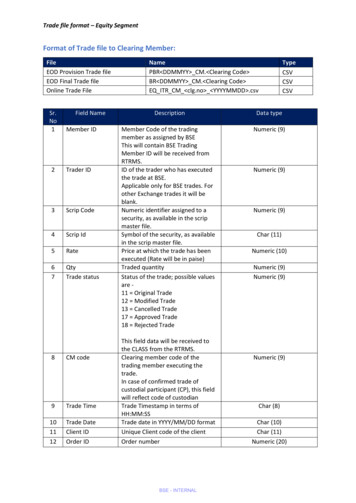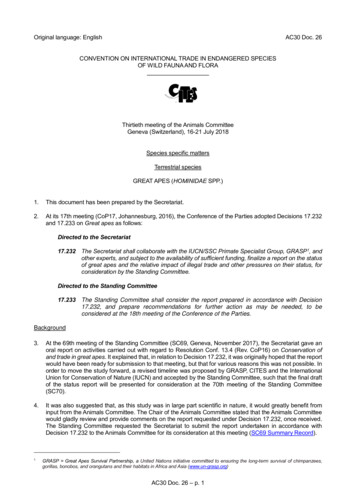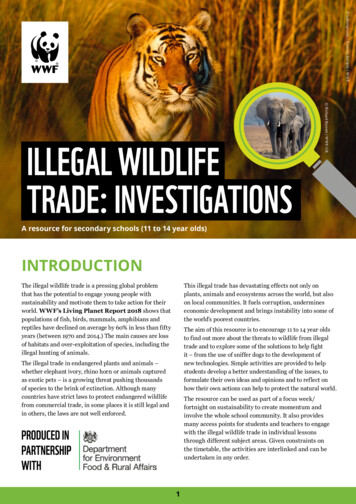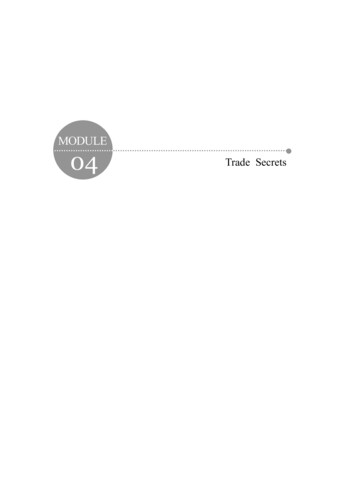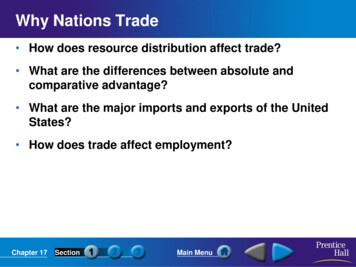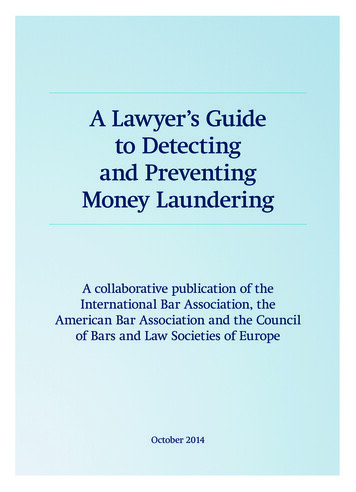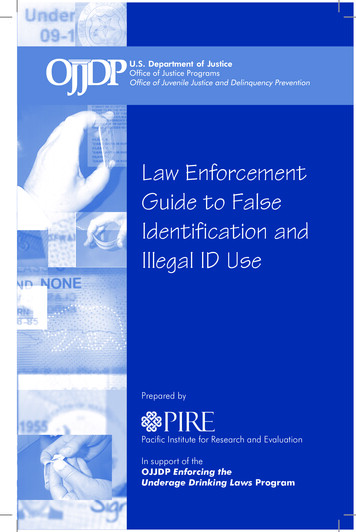
Transcription
CONVENTION ON INTERNATIONAL TRADE IN ENDANGERED SPECIES OF WILD FAUNA AND FLORA(CITES)THE ILLEGAL TRADE IN JAGUARS (PANTHERA ONCA)
CITES Study on the illegal trade in jaguars (Panthera onca)Author: Melissa AriasVersion: 05/07/2021 2021 by CITES Secretariat. All rights reserved. No part of this study may be reproduced withoutpermission of the CITES Secretariat.DISCLAIMERThe geographical designations employed in this document do not imply the expression of any opinionwhatsoever on the part of the CITES Secretariat (or the United Nations Environment Programme)concerning the legal status of any country, territory, or area, or concerning the delimitation of itsfrontiers or boundaries. The responsibility for the contents of this document rests exclusively with itsauthor.FUNDERSThis publication was made possible thanks to the financial support provided by Switzerland.2
CITES Study on the illegal trade in jaguars (Panthera onca)ACKNOWLEDGEMENTSGratitude is extended to the CITES authorities of jaguar range States, and those in source, transit anddestination countries, and to international and national organizations and other relevant stakeholders,who provided key information or access to data, to improve the understanding and knowledge baseon the illegal trade in jaguars. Special thanks go to:National Authorities:Ministerio de Ambiente y Desarrollo Sostenible de ArgentinaMinisterio de Medio Ambiente y Agua del Estado Plurinacional de BoliviaInstituto Brasileiro do Meio Ambiente e dos Recursos Naturais RenováveisWildlife Conservation Department, National Forestry and Grassland Administration of P.R. ChinaMinisterio de Ambiente y Desarrollo Sostenible de ColombiaMinisterio de Ambiente y Energía de Costa RicaCzech Environmental InspectorateMinisterio del Ambiente y Agua de EcuadorOffice Français de la Biodiversité – French GuianaConsejo Nacional de Áreas Protegidas de GuatemalaDepartamento de Vida Silvestre, Instituto de Conservación Forestal de HondurasSecretaria de Medio Ambiente y Recursos Naturales de MéxicoMinisterio del Ambiente y los Recursos Naturales de NicaraguaMinisterio de Ambiente de PanamáMinisterio de Agricultura y Riego de Perú, Servicio Nacional Forestal y de Fauna SilvestreMinisterio del Ambiente y Desarrollo Sostenible de ParaguaySerbia Ministry of Environmental ProtectionSuriname Forest ServiceMinisterio de Ambiente de UruguayUnited States Department of the Interior Fish and Wildlife ServiceIntergovernmental Bodies:Convention on International Trade in Endangered Species of Wild Fauna and Flora (CITES) SecretariatUnited Nations Office on Drugs and CrimeConvention on Migratory SpeciesInternational and National Organizations and Academia:Conservation International (CI) SurinameEarth League International (ELI)Environmental Investigation Agency (EIA)Freeland – BrazilFundación Moisés BertoniFundación Yaguará PanamaGuyra ParaguayHuman Initiative to Save Animals (HISA)IUCN Cat Specialist GroupIUCN Netherlands3
CITES Study on the illegal trade in jaguars (Panthera onca)Itaipú BinacionalPantheraPrimero ConservationRede Nacional de Combate ao Trafico de Animais SilvestresSociety for the Preservation of Endangered Carnivores and their International Ecological StudyTRAFFICWorld Animal ProtectionWildlife Conservation SocietyWild Tech DNAUniversidad Autónoma de MéxicoYaguará Panama FoundationSpecial appreciation is extended to the governments of Argentina, Colombia, Mexico, Panama,Paraguay and Venezuela, and to the Convention on Migratory Species and non-governmentalorganizations Panthera, Wildlife Conservation Society and Yaguará Panama Foundation for reviewingan earlier version of the report.The author thanks E.J. Milner-Gulland, Amy Hinsley, Mike ‘t Sas-Rolfes and Dan Challender from theOxford Martin Programme on the Wildlife Trade and University of Oxford for comments on the draft.This study was made possible thanks to the generous financial contribution of the Government ofSwitzerland. The CITES Secretariat would also like to thank the World Wide Fund for Nature (WWF)Mexico for funding the translation of the second draft into Spanish.4
CITES Study on the illegal trade in jaguars (Panthera onca)TABLE OF CONTENTSACKNOWLEDGEMENTS3TABLE OF CONTENTS5EXECUTIVE SUMMARY71.2.3.4.INTRODUCTION1.1Historical perspective on the trade in jaguars151.2Resumed attention to the illegal trade in jaguars161.3CITES Decisions on the illegal trade in jaguars17BACKGROUND ON JAGUARS7.192.1Biology, habitat, distribution and population size192.2Conservation status and threats202.3Socio-ecological and political importance22DATA COLLECTION, SOURCES OF INFORMATION AND METHODS233.1Data Collection233.2Data Analysis243.3Findings review26OVERVIEW OF THE ILLEGAL TRADE IN JAGUARS274.1Seizures reported on the UNODC’s World WISE Database274.2Seizures reported by governments responding to CITES Notification 055/2020294.3Poaching and illegal trade incidents found in the literature or reported by otherstakeholders314.4Mapping of jaguar poaching and illegal trade incidents:344.5Information challenges and limitations:355. JAGUAR BODY PART USES6.15395.1Domestic uses of jaguars and their body parts395.2Illegal uses of jaguar body parts outside the jaguar range435.3Prices of jaguar body parts46DRIVERS AND ENABLING FACTORS BEHIND THE ILLEGAL TRADE IN JAGUARS476.1Drivers of the illegal trade in jaguars476.2Enabling factors behind the illegal trade in jaguars55MODUS OPERANDI577.1Jaguar poaching contexts577.2Jaguar poaching methods597.3Supply chain description and illegal trading methods605
CITES Study on the illegal trade in jaguars (Panthera onca)8.9.IMPACTS OF THE ILLEGAL TRADE IN JAGUARS658.1Characterization of the potential effects of illegal offtake on jaguars668.2Biological characteristics influencing vulnerability to offtake678.3Exploratory analysis of the potential impacts of poaching and the illegal trade in jaguars 69INTERNATIONAL COOPERATION, REGIONAL EVENTS AND GLOBAL INITIATIVES739.1 CITES Decisions on Jaguars739.2 Inclusion of Jaguars in the Convention on Migratory Species (CMS)739.3 First High-Level Conference on Illegal Wildlife Trade in the Americas749.4 Regional alliances for jaguar conservation and against the illegal trade in jaguars749.5 The Jaguar 2030 Conservation Roadmap for the Americas7510. MAIN FINDINGS AND CONCLUSION76REFERENCES80APPENDIX – Jaguar Range Country Profiles and Variables of Vulnerability to Poaching and IllegalTrade96Methodological Notes96Country profiles with regards to jaguar population status, poaching and illegal trade in jaguars, andjaguar protections and conservation 8Colombia111Costa Rica113Ecuador115French Venezuela1396
CITES Study on the illegal trade in jaguars (Panthera onca)EXECUTIVE SUMMARYIn recent years, the illegal trade in jaguars has become a growing concern for the conservation of thespecies, following academic, media and NGO reports suggesting the emergence of internationaltrafficking to China, and the existence of thriving domestic markets for jaguar body parts across therange. Jaguar hunting, and the use and trade in their body parts have a long history in Latin America,tied to the traditional practices and belief systems of past and current indigenous and mixed-ethnicitysocieties. Through most of the 19th and 20th centuries, jaguars were hunted at commercial scales fortheir skins, to supply the fashion industry in Europe and North America. The listing of jaguars underAppendix I of the Convention on International Trade in Endangered Species of Wild Fauna and Flora(CITES) in 1975, which prohibits international commercial trade, along with the establishment ofnational hunting laws, successfully put an end to commercial-scale international trade in jaguars. Sincethen, illegal trade became a minor concern amidst a larger set of threats facing the species, includinghabitat loss, fragmentation and increased conflict with humans over real or perceived livestockdepredation. After nearly five decades since their listing under CITES, recent findings suggesting thatthe demand for jaguar body parts is expanding to other continents, particularly Asia, have raisedconcerns about the potential impacts of illegal trade on the survival of the species. These concernshave translated into conservation actions at the national and international level, including CITESDecisions 18.251 to18.253 on Jaguars (Panthera onca), adopted at the 18th meeting of the Conferenceof the Parties to CITES held in Geneva, Switzerland in August 2019. In accordance with Decision 18.251,the CITES Secretariat commissioned this study to:i) map illegal trade in the jaguar throughout its range, including poaching, trade pathways andnetworks, and main markets that are driving this trade, and how it is connected to other wildlifetrafficking activities in the region;ii) analyse the uses of jaguar specimens, both within range states and in international markets, as wellas the extent to which illegally-sourced jaguar products are entering international trade;iii) analyse the modus operandi associated with illegal trade in jaguar specimens and possible driversof this activity; andiv) characterize the overall impact of illegal trade on jaguar populations throughout the species’ range.Jaguars have a wide distribution, from the South-western United States to northern Argentina,covering 8.42 million km² across 19 countries (de la Torre et al., 2017). Despite being a highlycharismatic species, their population status is poorly understood and their abundance estimates varygreatly. Jaguars are classified as Near Threatened under the IUCN Red List. However, most jaguarsubpopulations with the exception of the Amazon subpopulation (including parts of the Pantanal,Yungas and Chaco biomes), have been assessed as Endangered or Critically Endangered due to theirsmall size, isolation and deficient protection (de la Torre et al., 2017). The threats to jaguars areincreasing, with deforestation growing inside and outside protected areas, driven by the expansion ofagriculture, cattle ranching, and human infrastructure. These threats have synergistic impacts onjaguars by increasing access of poachers into remote areas, reducing prey abundances, and increasingthe risk of human-jaguar conflict. Targeted poaching of jaguars for the illegal commercial trade addsto the pressures that jaguars are already facing, and may affect the survival of sub-populations thatare at critical risk of extinction. Understanding the scale, characteristics and impacts of this growingthreat to jaguars is essential to design and implement Decision 18.252, in particular paragraphs c) tog) as well as other effective jaguar conservation actions.7
CITES Study on the illegal trade in jaguars (Panthera onca)In accordance with Decision 18.252 Parties, especially those that are range States of the jaguar(Panthera onca) and relevant stakeholders, are encouraged to take action to:a) support the preparation of the study referred to under paragraph a) of Decision 18.251;b) respond to the Notification as described in paragraph c) of Decision 18.251;c) recognize the jaguar (Panthera onca) as the flagship species of its range countries so that theprotection and conservation of the species and its habitat becomes a joint priority;d) urgently adopt comprehensive legislation and enforcement controls aimed at eliminating thepoaching of jaguars (Panthera onca) and illegal trade in their parts and derivatives, including onlinesales of specimens;e) promote the design and implementation of conservation corridors between range countries of thejaguar (Panthera onca), strengthening cooperation mechanisms on a local, national and regional levelin order to promote good conservation practices, channel investments to the conservation of thespecies, reduce the threats to the connectivity of its habitats, and strengthen the capacities of themain players involved;f) raise awareness about the importance of the jaguar, its role in the ecosystem and the threats itfaces, including illegal trade;g) participate in conferences and workshops, among other events, in order to share experiences andknowledge about the priority issues identified to combat illegal trade in jaguars (Panthera onca); andh) consider making a voluntary contribution to conduct the study or implement its recommendations.Data collection, sources of information and methodsIn an effort to provide a comprehensive understanding of the illegal trade in jaguars, a wide range ofsources were consulted for this study. Official seizures were obtained from the CITES annual reportson illegal trade that are managed by United Nations Office on Drugs and Crime’s (UNODC) and includedin the UNODC’s World WISE Database. Also included in this Database are seizures from other globalwildlife trade databases, including the United States Fish and Wildlife Service’s Law EnforcementManagement Information System (LEMIS), the European Union’s Trade in Wildlife InformationExchange Database (EU-TWIX) and reports submitted independently by national governments. Adifferent set of official seizure data was obtained from governments’ responses to CITES Notification055/2020, which requested inputs for this study. Twenty governments, including 15 range States(Argentina, Bolivia, Brazil, Colombia, Costa Rica, Ecuador, France (French Guiana), Guatemala,Honduras, Mexico, Nicaragua, Panama, Paraguay, Peru, Suriname) and five non-range countries(China, Czech Republic, Serbia, United States1 and Uruguay), responded to this request and in additionto official seizures, provided official reports on the characteristics of the illegal trade in jaguars in theirterritories (uses, drivers, modus operandi, impacts). Additionally, a non-systematic literature searchwas conducted, adding 247 academic, media and grey literature reports. To these other literary andseizure inputs were added, collected by consulting 32 national and international experts and key1While the south-western tip of the United States is part of the jaguar range, the country has not been assessedas a jaguar range State in this report, due to the small and transient nature of its jaguar population. However,data on the illegal trade in jaguars in the United States is provided in Chapter 4.8
CITES Study on the illegal trade in jaguars (Panthera onca)informants, and by gaining access to other wildlife trade databases like TRAFFIC’s Wildlife Trade Portal,and to records shared by the Environmental Investigation Agency (EIA).Information challenges and limitationsA key conclusion of this study refers to the multiple challenges and limitations of the evidence that iscurrently available on the illegal trade in jaguars. The three main sources of information consulted inthis study (i.e. the UNODC’s World WISE Database, government responses to CITES Notification055/2020, and the general literature, including inputs obtained from a stakeholder consultation),presented important differences (and inconsistencies) in the scale and trends of seizures and reportsof poaching an illegal trade in jaguars, and in the markets of illegally traded jaguar specimens. Thesedifferences make it particularly challenging to ascertain, based on the limitations of the fragmentedinformation currently available, whether the illegal trade in jaguars is in fact increasing or not, andwhich are the main international and domestic markets for jaguar body parts. Moreover, all sourcesrevealed serious biases in reporting on the illegal trade in jaguars and poaching of the species acrosscountries, and a concerning lack of information and examples of effective law enforcement. Theselimitations stress the need for improved information systems on jaguar poaching and illegal trade, andof stronger law enforcement capabilities. These evidence deficiencies also mean that stakeholdersinvolved in addressing the illegal trade in jaguars should consider a wide range of sources together toobtain a more comprehensive understanding of this threat, and be particularly cautious about theimplications of data fragmentation, biases and limitations.Poaching and the illegal trade in jaguar specimensInformation on the quantities, characteristics and trends in seizures and reports of poaching and illegaltrade in jaguar specimens was analysed and presented separately for each of the three main types ofinformation sources consulted in this study: 1) the UNODC’s World WISE Database; 2) governmentresponses to CITES Notification 055/2020 requesting inputs for this study, and 3) the general literature,including inputs obtained from a stakeholder consultation and other wildlife trade databases. Thisseparation was meant to account for the sources’ differences in origins, methods and formality (officialvs. unofficial accounts).The UNODC’s World WISE Database contained 120 official jaguar seizure records for the years 2000 to2018, involving 179 specimens (or 101 whole organism equivalents). Seizures remained relativelystable in the past two decades, averaging 6.3 incidents per year, with the highest number of incidentsoccurring in 2017. The country with the largest number of seizures was the United States (49.2%)followed by Mexico (18.3%), Germany (5.8%), France (5%), Guatemala (4.2%) and French Guiana(2.5%). All remaining countries had less than two seizures in that period. The most commonly seizedjaguar body parts were skins (23%), teeth (21%) and live animals (12%). Peru was the most frequentsource of shipments of jaguar body parts (19 out of 78 records containing country of source - 24.4%),followed by Bolivia (14.1%) and Mexico (11.5%). The United States was the most frequent shipmentdestination (58 out of 76 records containing destination country – 76.3%), followed by Germany (5.3%)and China (4%).Based on jaguar poaching and seizure data submitted by 15 range, and five non-range State authoritiesin response to CITES Notification 055/2020, which requested inputs for this study, the number ofillegally traded jaguar body parts varied greatly by country, from one specimen reported by Serbia, to603 specimens reported by Bolivia. Most countries presented their seizures either as isolated incidentsor in an aggregated format, not permitting the evaluation of temporal trends. Out of those with yearlyreports (Bolivia, Peru, Suriname and the United States), the number of seizure events and specimensseized varied by country and time-frame, presenting both increasing and decreasing trends. The most9
CITES Study on the illegal trade in jaguars (Panthera onca)frequently seized specimens were jaguar teeth (totalling 689 teeth across reporting countries),followed by live animals (103), skins (65), and undefined jaguar products (63). The number of reportedjaguars poached in jaguar range countries (not necessarily due to illegal trade) ranged from one inMexico to 369 in Panama, with varying time frames. A few countries, including Argentina, Brazil,Mexico, Paraguay, Peru, Suriname, Czech Republic and Serbia presented evidence either suggestingor confirming the existence of international illegal trade in jaguar body parts (seizures made at airportsor border areas). Overall, there was limited evidence of international illegal trade in jaguars providedby countries, and the number of seizures for those with confirmed evidence were low.Based on poaching records and seizures reported in the academic, media and grey literature, or sharedby relevant stakeholders, countries with higher reported annual jaguar mortalities caused by poachingwere Bolivia (with an average of 61 reported jaguars poached per year), Brazil (54), Venezuela (31),Suriname (17) and Panama (12). With regards to seizures of jaguar specimens, Bolivia also had thehighest annual averages of seized or illegally traded specimens (30, whole organism equivalents),followed by China (12), Belize (9), Suriname (6), Peru (6) and Venezuela (6). Teeth were the mostcommonly traded items according to the literature. Jaguar poaching and illegal trading events(including supply, trade, or demand/possession) occurred in most Latin American countries and oftenoverlapped geographically, but illegal trade incidents were not limited to the jaguar range and alsotook place in urban areas, ports of exit or smuggling routes. Since the literature sources analysed inthis study were collected in a purposive way and they varied in type, methods, quality and detectioneffort, it is not appropriate to draw conclusions about trends in reporting on jaguar poaching or illegaltrade in jaguars, nor in the number of reported incidents or specimens seized from this dataset.However, systematic searches of jaguar seizures in the literature (such as Morcatty et al., 2020), havedetected increasing trends in jaguar seizures and in the number of illegally traded specimens over thepast decade, and the sources analysed herein point to a similar conclusion.Uses of jaguar specimensJaguars are part of the identity, artistic traditions, myths, and rituals of multiple past and modernindigenous societies in Latin America, and they also have a cultural significance for mixed ethnicitycommunities that coexist with the species throughout its range. Cultural and social motivations behindthe use of jaguar body parts, along with other commercial and non-commercial drivers of use at thedomestic level, have not received substantial research attention, but they are widespread and canoccur at potentially unsustainable scales. Based on all sources consulted in this study (includinggovernment information and literature reports), almost all jaguar body parts are used at the domesticlevel. Jaguar teeth are the most sought-after jaguar part, being used as jewellery, symbolizing braveryand status, or as spiritual amulets. Skins are used to make traditional costumes or decorative wallhangings, as well as a wide range of garments and accessories such as purses, hats, belts and wallets.Skins, along with skulls and taxidermies serve as trophies, or as proof of effective predator control.Jaguar cubs are kept as pets or sold as attractions for private wildlife collections. Small items like claws,tails, paws, and organs have a range of decorative and medicinal uses. Jaguar fat was reported as akey item by several studies, being used to allegedly treat a wide range of illnesses, from rheumatismto asthma, and also serving as a natural protection against crop raiding animals. Jaguar meat was alsoconsumed for nutritional and cultural reasons.There is less robust evidence about the uses of jaguar body parts outside of jaguar range States. Thisremains one of the most significant gaps in current knowledge about the illegal trade in jaguars. Theuses of jaguar body parts in the United States, Germany and other European countries, which hadjaguar seizures reported in the UNODC’s World WISE Database, have received limited attention andremain largely unknown. While media coverage of international illegal trade in jaguars has assumedthat jaguar body parts are being used in Traditional Chinese Medicine as substitutes of tiger body parts,10
CITES Study on the illegal trade in jaguars (Panthera onca)this hypothesis currently holds little weight due to the overall limited seizure evidence of ‘jaguar paste’(boiled bones and flesh) or other jaguar-based medicinal products in China or elsewhere. On the otherhand, existing seizures of China-bound jaguar teeth suggest that these items may be used in China asstatus-granting collectibles, as part of the Chinese subculture of ‘Wenwan’. However, there is limitedresearch or confirmed information on the uses of jaguar body parts in China. Jaguar body parts arealso used to make jewellery, handcrafts and souvenirs for domestic and foreign tourists. Jaguar bodyparts’ prices vary widely, suggesting large information asymmetries in the market.Drivers behind the illegal trade in jaguarsThe consulted sources provided key insights into the multiple drivers of the illegal trade in jaguars.Domestic markets and traditional uses of jaguar body parts make jaguars a target of demand, whileforest dependent livelihoods like hunting for wild meat, logging, non-timber forest product collectionand mining, increase the odds of accessing jaguars. Negative attitudes towards jaguars caused by fear,and by the emotional and financial losses imposed by livestock-depredating jaguars, lead to retaliatorykilling and to a compensating usage of the resulting body parts. These incidents are ever more frequentdue to encroachment of jaguar habitat by cattle ranching and the advancement of the agriculturalfrontier. Financial incentives from the high prices of jaguar body parts make jaguar poaching anattractive complement to rural livelihoods, and also attract people with higher incomes. Demand fromforeign markets has emerged as yet another driver of poaching and the illegal trade in jaguars. Jaguarbody parts have been smuggled to the United States and Europe, but the characteristics of demand inthese countries is not well understood. Seizures of jaguar body parts in countries like Bolivia andSuriname, which were either destined to China or illegally traded by jaguar traffickers of Chinesedescent (unconfirmed nationality and migratory status) have highlighted the role of Chinese wildlifemarkets in the demand for jaguar body parts. Tourism, involving both domestic and foreign tourists,offers another opportunity to sell jaguar crafts and souvenirs to a wealthier consumer base. Forcountries like Peru, Mexico, Guatemala and Belize, tourism is a well-evidenced driver, with multiplejaguar body part seizures made at crafts shops, restaurants, hotels and facilities located at touristdestinations. The desire to possess live jaguars as household pets or as part of private wildlifecollections, as tourist attractions or for personal enjoyment, was identified as another driver of theillegal trade in jaguars. Trophy hunting, though banned throughout the jaguar range, was a lesscommon but persisting driver of jaguar poaching and of the illegal possession and trade in jaguarspecimens.There is limited empirical evidence on the relative importance of these divers on jaguar populationswhen compared to each other, and to other threats facing jaguars, such as habitat loss. However, bothopportunistic poaching associated with domestic markets, traditional uses and local livelihoods, andhuman-jaguar conflict appear to be responsible for the greatest numbers of poached and illegallytraded jaguars. Addressing these drivers can become a challenge in the presence of several contextualand institutional factors that facilitate the illegal trade in jaguars in range countries, including a lack offinancial and human resources for adequate enforcement, corruption, legal deficiencies, and lack ofawareness about jaguars and their legal status. Tackling poaching and the illegal trade in jaguars willrequire multifaceted strategies that focus on the multiple drivers and enabling factors behind thesethreats, from increased enforcement to detect and stop transboundary illegal trade, to awarenessbuilding, behaviour-change, human-wildlife conflict mitigation approaches and habitat conservation.Modus operandiJaguar poaching occurs opportunistically, when poachers encounter jaguars by chance, orintentionally, when poachers explicitly search for jaguars following attacks on livestock, for illegal sporthunting activities or for trafficking purposes. Targeted poaching also occurs by order of traffickers or11
CITES Study on the illegal trade in jaguars (Panthera onca)consumers. Jaguar poaching orders are delivered in different ways, including through the use of wideaudience communication channels like radio broadcasts or paper flyers posted in public spaces, socialmedia, or by directly approaching potential suppliers and establishing illegal trading networks. Themethods used to kill jaguars resemble those used during the commercial hunting of spotted cats forthe fur trade until the 1970’s, including specialized active and passive capture tactics and luringmethods. Poached jaguars, or their body parts, are transported by roads or rivers from the forest tovillages, tanneries, saddleries, shops and other facilities for processing. They are then sold at customerfacing outlets (e.g. craft markets in tourist areas, jewellery shops), online platforms/social media, orthrough networks of trusted friends or family. Seizures involving illegal international trafficking ofjaguar body parts have confirmed the use of postal services and commercial air travel to smugglejaguar body parts. While the involvement of organized criminal groups in the illegal trade in jaguarshas been suggested, and few countries like Bolivia and Brazil present more structured trade networks,verified examples suggest that the illegal trade in jaguars remains a largely opportunistic and informalactivity. More research and enforcement efforts by range State authorities are needed to confirm theinvolvement of organized criminal groups and the degree to which the illegal trade in jaguars may belinked to other crimes.Impacts of the illegal trade in jaguarsDespite its great adaptability and strength, the jaguar is a slow reproducing species that occurs atnaturally low densities, and which is sensitive to humans. The impacts of poaching and the illegal tradein jaguars will depend on each country’s specific jaguar conservation status (and vulnerability to otherthreats such as habitat loss), levels and characteristics of poaching and illegal trade, and ability torespond to these threats given their current legal systems and institutional capacities. Based on anexploratory qualitative analysis of these factors, it was possible to determine that jaguar populationsthat are small, fragmented, and highly endangered by other threats such as habitat loss (such as thoseoutside of the
Ministerio del Ambiente y los Recursos Naturales de Nicaragua Ministerio de Ambiente de Panamá Ministerio de Agricultura y Riego de Perú, Servicio Nacional Forestal y de Fauna Silvestre . Universidad Autónoma de México Yaguará Panama Foundation Special appreciation is extended to the governments of Argentina, Colombia, Mexico, Panama, .


